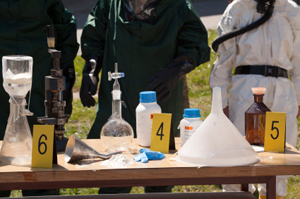February 13, 2012
How Not To Control Drug Abuse: What Were They Thinking?

By Michael D. Shaw
A most interesting conceit of the human race, which seems to date back to the dawn of civilization, is the notion of chronological superiority. Virtually all historical narrative includes—or at least implies—an air of condescension. Pity those poor unfortunates, who did not have the advantage of our modern enlightenment.
We marvel at the strange medical procedures of the past; we ridicule those foolish Redcoats during the Revolution, all lined up two-by-two, as if they were fighting the previous war; and we shake our heads in bewilderment at those sophisticates of the mid-20th century, who thought smoking was cool, even as they coughed up a lung every morning. We wonder: “What were they thinking?”
Yet, as you will see, we are no different. Indeed, despite all of our so-called enlightenment, we are no better than our ancestors.
Few policies in our nation’s history are more widely mocked than Prohibition. But this was no dictatorial regulatory fiat. Rather, it required a constitutional amendment (the 18th), meaning that it had to pass through both houses of Congress and then be ratified by three-fourths of the states. No doubt, there was considerable public support for this measure when it appeared in 1919.
Yet, it would soon become highly unpopular. The public’s taste for alcohol was hardly affected, enforcement was spotty at best, and legions of organized crime figures thrived. By the early 1930s, public pressure became overwhelming, and the repeal amendment (21st) would be ratified on December 5, 1933.
Fast forward to the present. Various drugs “of abuse” are illegal, and billions of dollars are spent on the War On Drugs. Yet, the public’s taste for these drugs has hardly been affected, enforcement is spotty at best, and legions of organized crime figures are thriving. So much for the lessons of history. Too bad the story gets worse.
Methamphetamine is a prescription-only legal drug, approved by the FDA for treating attention deficit hyperactivity disorder (ADHD) and obesity. The drug is highly addictive, and comes with a long list of side effects—some devastating, and some paradoxical, such as a combination of increased libido and impotence. For many reasons, including its relative ease of manufacture and its use in clinics to treat heroin addiction, it became a preferred drug of abuse.
The illegal manufacture of methamphetamine generally requires a chemical ingredient that can be derived from pseudoephedrine, a pharmaceutical found in over-the-counter cold, cough, and allergy medications such as Sudafed, Advil Cold and Sinus, Allegra D, Mucinex D, and Claritin D.
Recognizing that it had a big problem with methamphetamine abuse, in 2004 Oregon became one of the first states to put medications containing pseudoephedrine behind the counter. This Oregon law also limited the amount of such meds that could be purchased at one time. Two years later, the Feds would follow suit with their Combat Methamphetamine Epidemic Act (CMEA). Now, all pharmacies in the US would hide these “dangerous” cold remedies behind the counter.
Soon after, Oregon went even further. In September, 2006 the Beaver State passed a law requiring prescriptions to obtain all pseudoephedrine-based cold remedies. Mississippi would match this in 2009.
OK, let’s take stock. Methamphetamine—a pharmaceutical drug with potentially dangerous side effects—is regulated so that it is dispensed only with a valid prescription. However, this very same compound is so popular with drug abusers that a number of over-the-counter formulations are being cannibalized to aid in its illicit manufacture and distribution.
Even though prescription-only (Rx-only) dispensing of methamphetamine has been remarkably ineffective in controlling its abuse, two states have invoked the Rx-only model to control the availability of a precursor necessary for its illegal manufacturing.
Apologists for this absurdity are quick to point out that the number of methamphetamine lab incidents in Oregon has declined significantly. Typically, though, they do not mention that a similar trend is also evident in neighboring states, not requiring a prescription for pseudoephedrine-based products.
While incidents related to the manufacture of methamphetamine in Oregon and neighboring states have declined, the drug continues to be widely available in Oregon. Law enforcement agencies believe that local manufacture has been replaced by trafficking of finished product from other states and Mexico. When there’s a will, there’s a way, right?
As with all regulatory overreach, there is far more harm to the innocent than control of the violators. How many cold sufferers will forgo obtaining a prescription for these formerly OTC meds, possibly endangering their health? And for those who do contact a physician, an extra burden is added to our already beleaguered health care system.
50 years from now, our descendants will look back on this and ask, “What were they thinking?”

